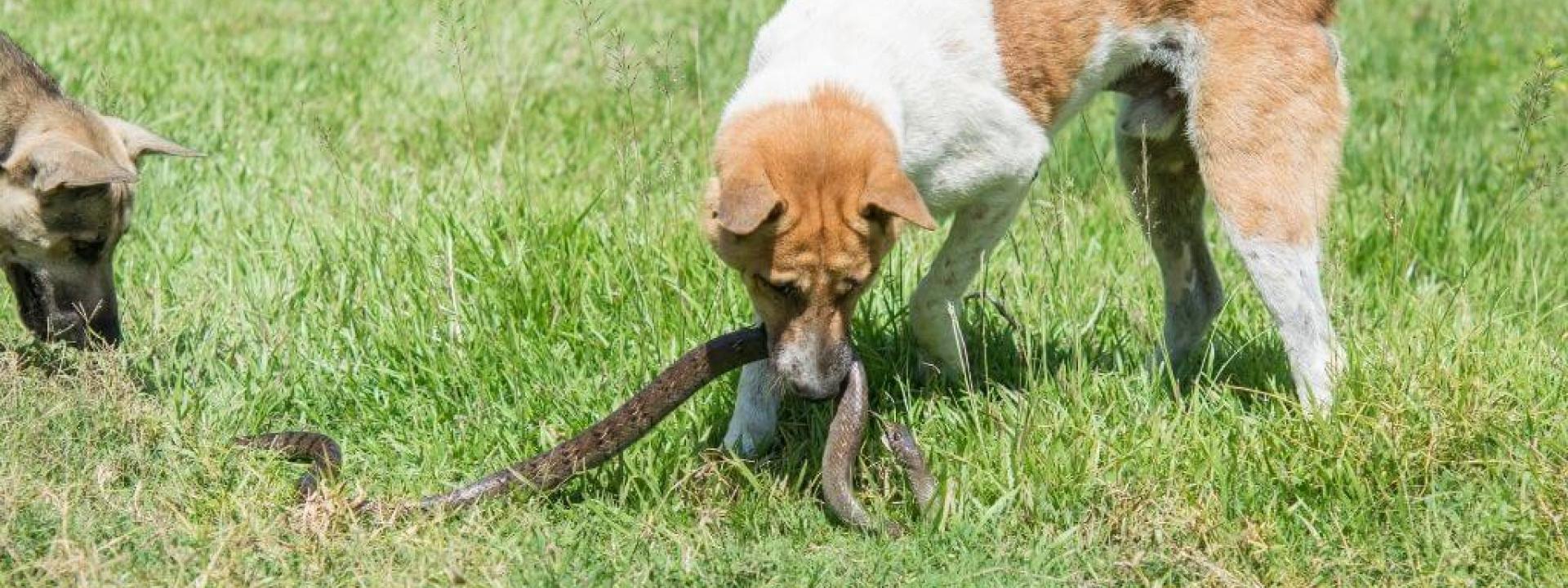You’re taking the dog out on a hike, and he suddenly veers off the path to explore something that caught his eye—now, you and your precious pup are face to face with a rattlesnake. It’s a scary circumstance to find yourself in, but one that does indeed happen and one that dog owners don’t often think about. Dogs are curious (and, let’s face it, a bit goofy) creatures! Snakes pose a serious threat to your dog, especially during Spring when warmer weather arrives, and snakes seek out the sun for warmth after a long, cold winter. Something even as routine and harmless as allowing your dog to run around the yard while you tend to landscaping, weeding, and gardening can prove to be dangerous.
As veterinarians, we want all dog owners to be well-informed of snake dangers, including how to prevent an encounter and the immediate steps to take if your dog is bitten. Quick action can mean the difference between life and death for your beloved dog – especially for smaller breeds since their body size reacts more severely to venom.
Avoiding Snakes When Taking Your Dog Outside
Regardless of your outdoor environment, some simple precautions can help you avoid a face-to-face encounter between your dog and a venomous snake.
Some of the ways in which you can keep your dog protected from snakes while outdoors are as follows:
- When playing in the yard or out on a hike, avoid letting your dog explore holes or dig under rocks, where snakes could be living.
- When hiking, stick to open paths, avoid high grass areas, and keep your dog on a leash.
- Actively listen for the typical rattling or vibrating noise that snakes make. While rattlesnakes have a very specific rattle, many other snakes also vibrate their tales when threatened.
- Don’t let your dog explore a dead snake you may encounter in your yard or on the trails, as they can still envenomate.
- At home, cut off a snake’s food supply and shelter opportunities by mowing your lawn close to the house, storing firewood away from the house, and filling any holes in your yard.
Signs Your Dog May Have Been Bitten
If your dog was running around the yard or hiking trails freely, and the bite wasn’t observed, it’s important to know the signs so you can take immediate action. This is especially vital if a dog’s fur coat is thick enough to hide a puncture wound.
The initial signs of a snake bite include bleeding, swelling, and intense pain, followed by:
- Skin discoloration
- Vomiting
- Muscle tremors
- Excessive salivation
- Shallow breathing
- Limb weakness
What to Do If Your Dog is Bitten
If your dog is bitten by a snake, the rule of thumb is to assume it was a venomous snake and seek attention from your veterinarian immediately.
In the time between the bite and getting your dog to the vet, follow these guidelines:
- Keep yourself and your pet calm. If you are distressed, your dog will be too.
- Keep your dog immobile, carrying them if possible.
- Try to keep the bitten area at or below the level of their heart.
- If the bite and/or swelling is not in the face, muzzle your dog to protect yourself. Snake bites are very painful and may cause your dog to act uncharacteristically and snap at you.
- Avoid touching the bite area.
What NOT to Do If Your Dog is Bitten
There are several things a dog owner might instinctively think to do to help their dog manage the pain, but these actions could ultimately make the situation worse.
The following are things not recommended by veterinarians to do if you suspect a snake bite:
- Do not give your dog medications you have at home, such as Benadryl, to help keep them calm and immobile.
- Do not use a tourniquet, as this will only further damage the tissue and can lead to limb amputation.
- Do not attempt to suck the venom out.
- Do not use a Snake Bite Kit or Extractor Pump, as they will do more harm than good for your dog.
- Do not apply ice to the area. Ice constricts the blood vessels locally and concentrates the venom, causing severe muscle damage.
- Do not attempt to capture the snake for identification. Assume it was venomous and react accordingly.
How Veterinarians Treat Snake-Bitten Dogs
Antivenom is the most common course of treatment once your dog is in the veterinarian’s care. The earlier it is administered, the more effective it will be. While your dog may be okay without antivenom, and it is expensive if you’re not sure it was a venomous snake, it reduces the severity of symptoms, speeds recovery, and greatly improves the chances of survival. Your veterinarian will likely suggest that your dog remain in the hospital for 12-24 hours to monitor progress and help with pain management. The good news is that 95% of dogs survive snake bites with swift action on your part quick treatment by your vet.
If you encounter a snake, remember they will only strike if threatened. Back away slowly, and the snake will most likely slither away to a space that feels safer. As this article by Texas A & M University's School of Veterinary Medicine notes, dogs that are outside a lot may even benefit from a formal training course on how to leave snakes alone or avoid them. If you’d like more information on how to keep your dog safe during snake season, please don’t hesitate to give us a call. And again, if you suspect your dog has been bitten, get them in to see us right away.

